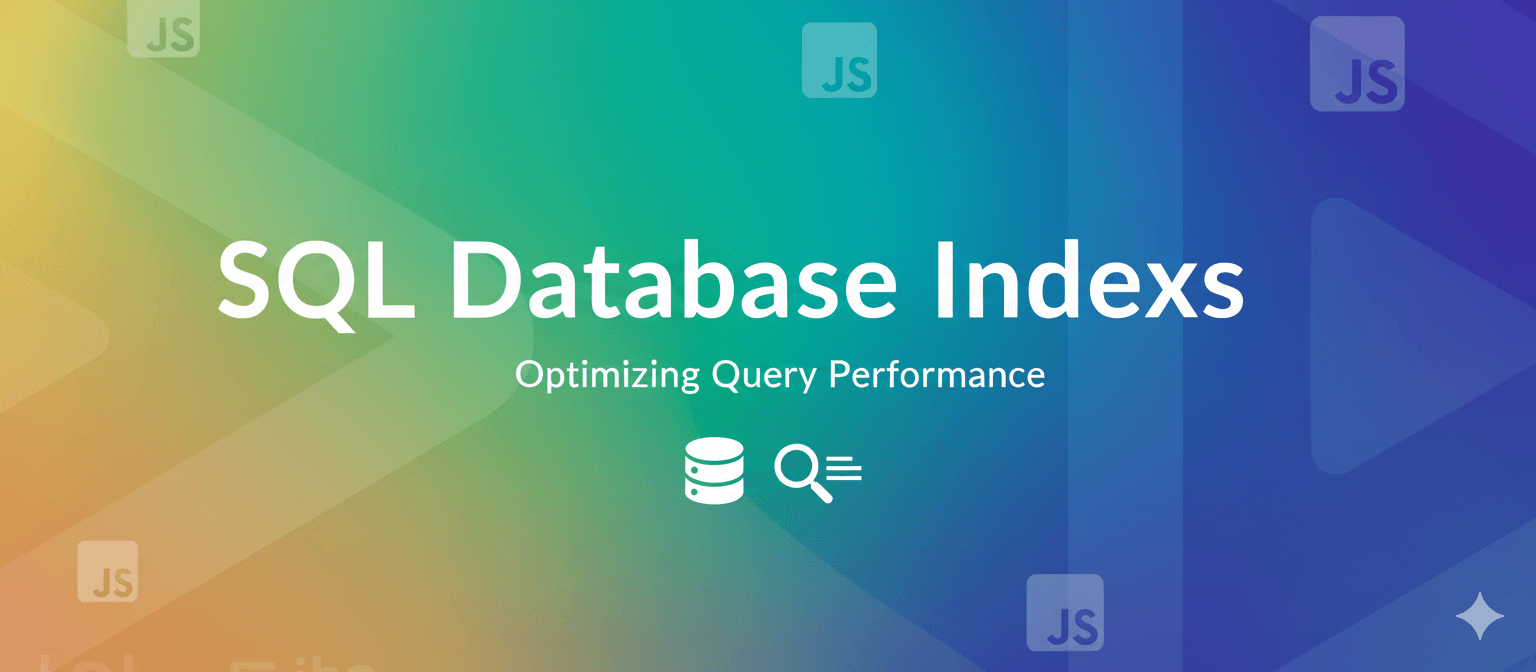Mastering Database Indexes: A Complete Guide to SQL Indexes in PostgreSQL, MySQL, and MariaDB

Deep dive into database indexes with practical examples and performance insights. Learn how to create, optimize, and manage indexes across PostgreSQL, MySQL, and MariaDB. Includes detailed code examples, best practices, and real-world scenarios to boost query performance by up to 100x.
Introduction
Database indexes are one of the most powerful tools for optimizing query performance. Understanding when and how to use indexes can transform slow queries into lightning-fast operations. This comprehensive guide covers index fundamentals, types, and implementation across major SQL databases.
What Are Database Indexes?
Indexes are data structures that improve the speed of data retrieval operations on database tables. Think of them like a book's index - instead of reading every page to find a topic, you jump directly to the relevant pages.
Basic Concept Example:
1-- Without index: Full table scan
2SELECT * FROM users WHERE email = 'john@example.com';
3-- Scans all 1,000,000 rows
4
5-- With index on email column
6CREATE INDEX idx_users_email ON users(email);
7-- Now searches through index tree structure
8-- Reduces search from 1,000,000 to ~20 operations (log2(n))Types of Indexes
1. Single-Column Index
1-- PostgreSQL/MySQL/MariaDB (similar syntax)
2CREATE INDEX idx_user_lastname ON users(last_name);
3
4-- Using the index
5SELECT * FROM users WHERE last_name = 'Smith';2. Composite (Multi-Column) Index
1-- Order matters! Index on (last_name, first_name)
2CREATE INDEX idx_user_name ON users(last_name, first_name);
3
4-- Efficient queries:
5SELECT * FROM users WHERE last_name = 'Smith';
6SELECT * FROM users WHERE last_name = 'Smith' AND first_name = 'John';
7
8-- Inefficient (doesn't use index):
9SELECT * FROM users WHERE first_name = 'John';3. Unique Index
1-- PostgreSQL/MySQL/MariaDB
2CREATE UNIQUE INDEX idx_users_email ON users(email);
3
4-- Alternative using constraint
5ALTER TABLE users ADD CONSTRAINT uk_email UNIQUE (email);4. Partial Index (PostgreSQL)
1-- PostgreSQL only
2CREATE INDEX idx_active_users ON users(created_at)
3WHERE status = 'active';
4
5-- Efficient query
6SELECT * FROM users
7WHERE status = 'active' AND created_at > '2025-01-01';5. Full-Text Index
PostgreSQL:
1-- Create GIN index for full-text search
2CREATE INDEX idx_posts_content ON posts
3USING GIN(to_tsvector('english', content));
4
5-- Search query
6SELECT * FROM posts
7WHERE to_tsvector('english', content) @@ to_tsquery('database & index');MySQL/MariaDB:
1-- Create FULLTEXT index
2CREATE FULLTEXT INDEX idx_posts_content ON posts(content);
3
4-- Search query
5SELECT * FROM posts
6WHERE MATCH(content) AGAINST('database index' IN NATURAL LANGUAGE MODE);Database-Specific Index Types
PostgreSQL Specific
B-tree Index (default):
1CREATE INDEX idx_users_age ON users(age);Hash Index:
1CREATE INDEX idx_users_id_hash ON users USING HASH(id);
2-- Good for equality comparisons onlyGiST Index (Geometric):
1CREATE INDEX idx_locations ON stores USING GIST(location);
2-- For spatial data, ranges, and custom typesGIN Index (Inverted):
1CREATE INDEX idx_tags ON articles USING GIN(tags);
2-- For JSONB, arrays, and full-text searchMySQL/MariaDB Specific
Spatial Index:
1CREATE SPATIAL INDEX idx_location ON stores(coordinates);
2-- For GEOMETRY, POINT, LINESTRING typesDescending Index (MySQL 8.0+):
1CREATE INDEX idx_created_desc ON posts(created_at DESC);Viewing Existing Indexes
PostgreSQL:
1-- All indexes on a table
2SELECT indexname, indexdef
3FROM pg_indexes
4WHERE tablename = 'users';
5
6-- Detailed index information
7\d+ usersMySQL/MariaDB:
1-- Show all indexes
2SHOW INDEX FROM users;
3
4-- Detailed index information
5SHOW CREATE TABLE users;Analyzing Index Usage
PostgreSQL:
1-- Check query execution plan
2EXPLAIN ANALYZE
3SELECT * FROM users WHERE email = 'john@example.com';
4
5-- Index usage statistics
6SELECT
7 schemaname, tablename, indexname,
8 idx_scan, idx_tup_read, idx_tup_fetch
9FROM pg_stat_user_indexes
10WHERE tablename = 'users';MySQL/MariaDB:
1-- Check query execution plan
2EXPLAIN
3SELECT * FROM users WHERE email = 'john@example.com';
4
5-- Force index usage
6SELECT * FROM users
7FORCE INDEX (idx_users_email)
8WHERE email = 'john@example.com';Dropping and Rebuilding Indexes
1-- PostgreSQL/MySQL/MariaDB
2DROP INDEX idx_users_email;
3
4-- PostgreSQL - rebuild index
5REINDEX INDEX idx_users_email;
6
7-- MySQL/MariaDB - optimize table (rebuilds indexes)
8OPTIMIZE TABLE users;Real-World Performance Example
Scenario: E-commerce Order Query
1-- Create orders table
2CREATE TABLE orders (
3 id SERIAL PRIMARY KEY,
4 user_id INT,
5 status VARCHAR(20),
6 created_at TIMESTAMP,
7 total_amount DECIMAL(10,2)
8);
9
10-- Insert sample data (1 million records)
11-- Without indexes - slow query
12SELECT * FROM orders
13WHERE user_id = 12345
14AND status = 'completed'
15AND created_at > '2025-01-01';
16-- Execution time: 2.5 seconds
17
18-- Add composite index
19CREATE INDEX idx_orders_lookup
20ON orders(user_id, status, created_at);
21
22-- Same query with index
23-- Execution time: 0.02 seconds (125x faster!)Best Practices
Create indexes on:
Avoid indexing:
Composite Index Strategy:
1-- Good: Most selective column first
2CREATE INDEX idx_search ON products(category_id, price, name);
3
4-- Query patterns this supports:
5-- ✓ WHERE category_id = 1
6-- ✓ WHERE category_id = 1 AND price > 100
7-- ✓ WHERE category_id = 1 AND price > 100 AND name LIKE 'A%'
8-- ✗ WHERE price > 100 (doesn't use index efficiently)Common Index Pitfalls
Using Functions on Indexed Columns:
1-- Bad: Function prevents index usage
2SELECT * FROM users WHERE LOWER(email) = 'john@example.com';
3
4-- Good: Store lowercase or use functional index
5-- PostgreSQL
6CREATE INDEX idx_email_lower ON users(LOWER(email));Implicit Type Conversion:
1-- Bad: String column compared to number
2SELECT * FROM users WHERE phone_number = 1234567890;
3
4-- Good: Use proper type
5SELECT * FROM users WHERE phone_number = '1234567890';Monitoring Index Health
PostgreSQL - Find Unused Indexes:
1SELECT
2 schemaname, tablename, indexname, idx_scan
3FROM pg_stat_user_indexes
4WHERE idx_scan = 0
5AND indexrelname NOT LIKE 'pg_toast%';MySQL/MariaDB - Check Index Statistics:
1SELECT
2 TABLE_NAME, INDEX_NAME, CARDINALITY
3FROM information_schema.STATISTICS
4WHERE TABLE_SCHEMA = 'your_database'
5ORDER BY TABLE_NAME, SEQ_IN_INDEX;Conclusion
Proper index design is crucial for database performance. Start with the most frequently used queries, analyze execution plans, and create indexes strategically to optimize performance. Remember that indexes have trade-offs - they speed up reads but slow down writes. Regular monitoring and maintenance ensure your indexes remain effective as your data grows.
